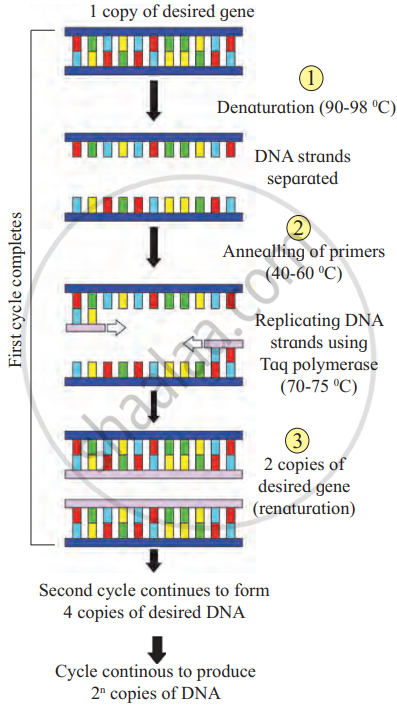Advertisements
Advertisements
प्रश्न
Describe the steps of PCR technique.
Explain different steps involved in PCR technique.
उत्तर १
- Step i: The reaction mixture is heated to a temperature (90-98°C) to separate two strands of desired DNA. This is called denaturation.
- Step ii: The mixture is allowed to cool (40-60°C) that permits pairing of the primer to the complementary sequences in DNA. This step is called annealing.
- Step iii: The temperature (70-75°C) allows thermostable Taq DNA polymerase to use single-stranded DNA as a template and adds nucleotides. This is called primer extension. It takes around two minutes duration.
 |
| DNA replication through polymerase chain reaction |
उत्तर २
The three essential steps of the PCR technique are:
1. Heat denaturation: This step involves the heating of DNA at about 91°C. The heating breaks the hydrogen bonds to make ssDNA. The DNA molecule with more G-C pairs needs a higher temperature.
2. Annealing: It is the pairing of primers to the ssDNA segment. The primers have to be designed as per the requirement. This step requires temperature at about 55°C
3. Polymerisation: The temperature is raised to 72°C. The Taq polymerase adds dNTPs behind the primer on the ssDNA. These three steps constitute one cycle of the reaction (3-5 mins). The process is carried out for about 28-30 cycles beyond which its reliability decreases.
संबंधित प्रश्न
Mention some food items prepared with the help of microbes around the world.
Bacterias that can be used as manure.
Match the following.
| Living organism | Substance that absorbs |
| 1) Pseudomonas | a) Radiations |
| 2) Pteris vittata | b) Hydrocarbons |
| c) Arsenic | |
| d) Uranium |
Explain the commercial applications of biotechnology with examples.
How is biotechnology useful for human health? Explain with an example.
In gene therapy, which of the following can be used to dissolve blood clots present in the body?
Which of the following components are used for improving fish quality?
______ is not used as bio-fertilizers.
Classify the following to form Column B as per the category given m Column A.
- Provide tissues for human transplants
- Cancer research
- E. coli hygromycin-resistant gene
- Supply of factor IX.
| Column A: (Transgenic animal) |
Column B: (Application) |
|
| (a) | Transgenic mice | |
| (b) | Transgenic cattle | |
| (c) | Pig clones | |
| (d) | Transgenic fish |
Define the Transduction.
